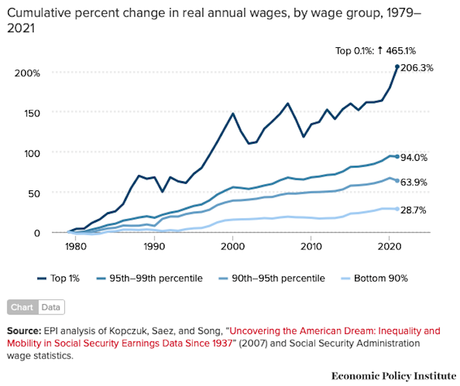
Since about 1980, there has been an increasing economic inequality between the top 1% and the bottom 90% of Americans. It has now grown so large that it exceeds the economic inequality that existed right before the Great Depression -- and it continues to grow worse. This is no accident. It is the intentional result of Republican "trickle-down" economic policies that tilted the economic playing field to benefit the rich at the expense of most Americans.
Elise Gould and Jori Sandra of the Economic Policy Institute have written an excellent article about this (and I recommend reading the whole article). Here is their conclusion:
The level of earnings inequality that existed in 1979 could have simply continued through to today. Instead, we have seen a growing concentration of earnings at the top and the very top of the earnings distribution, while the bottom 90% has experienced meager gains. Wages for the top 1% grew more than seven times fast as wages for the bottom 90% between 1979 and 2021. The top 1% now amasses a record share of total earnings, while the bottom 90% share of earnings has hit a historic low.
This slow progress for the vast majority of workers reaffirms the need to place robust wage growth and worker power at the center of economic policymaking. Over the last four decades, a series of policies have reduced the leverage of most workers to achieve faster wage growth (Mishel and Bivens 2021). Such policies include:
- tolerating (or even encouraging) excessive unemployment
- failing to routinely raise the federal minimum wage to protect workers’ purchasing power
- writing the rules of globalization to let employers use them as a tool for wage suppression
- withering of labor standards, like the overtime threshold governing how many workers are entitled to higher pay for longer hours
- lack of enforcement against wage theft
- allowing discrimination based on gender, race, and ethnicity
- new employer-mandated agreements that reduce worker bargaining power, such as noncompetes and mandatory arbitration of grievances
- fissuring of the workplace and supply-chain dominance
- sharp cuts in marginal tax rates, deregulation, and loose corporate governance oversight, which led to explosions in executive and financial-sector pay
Most critically, current labor law does not adequately protect workers’ right to form unions. With the possible exception of excess unemployment, declining union membership plays the single most significant role in slow and unequal wage growth (Mishel and Bivens 2021). This erosion was not driven by workers’ declining interest in unions, but rather by concerted employer opposition, along with state and federal policy that has made it nearly impossible for workers to form unions in the face of unwilling employers (Rosenfeld, Denice, and Laird 2016; McNicholas et al. 2019).
To stem inequality and see healthy wage growth for the vast majority of workers, we need to use all the tools in our toolbox to reverse these policy trends—including prioritizing full employment, strengthening and enforcing labor standards, and removing obstacles to workers forming unions.

